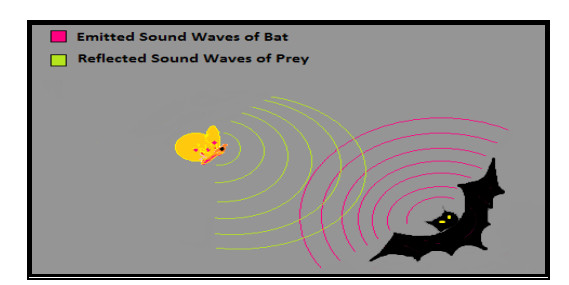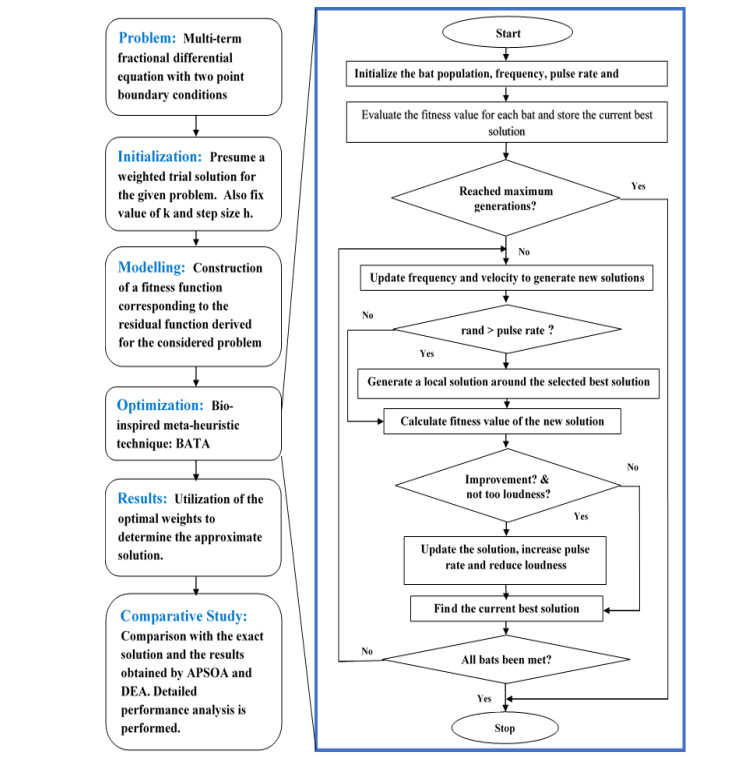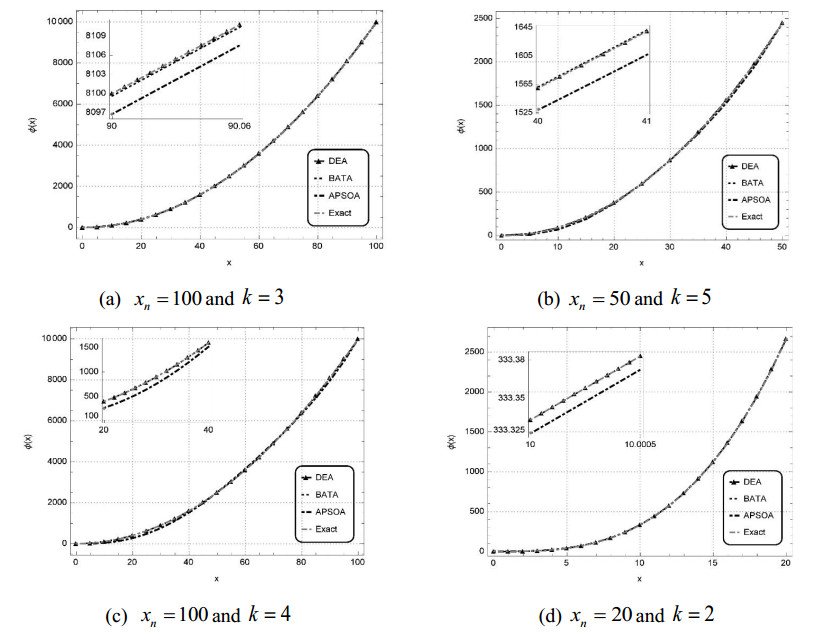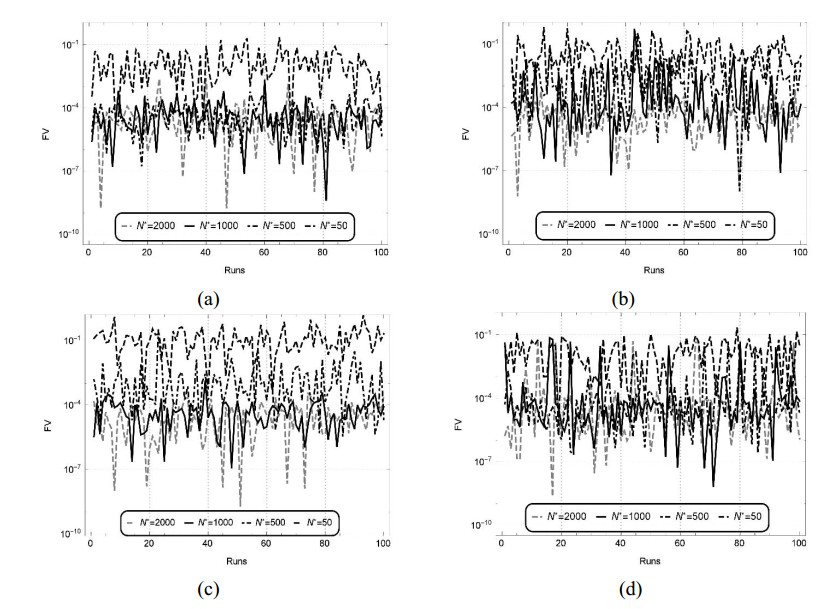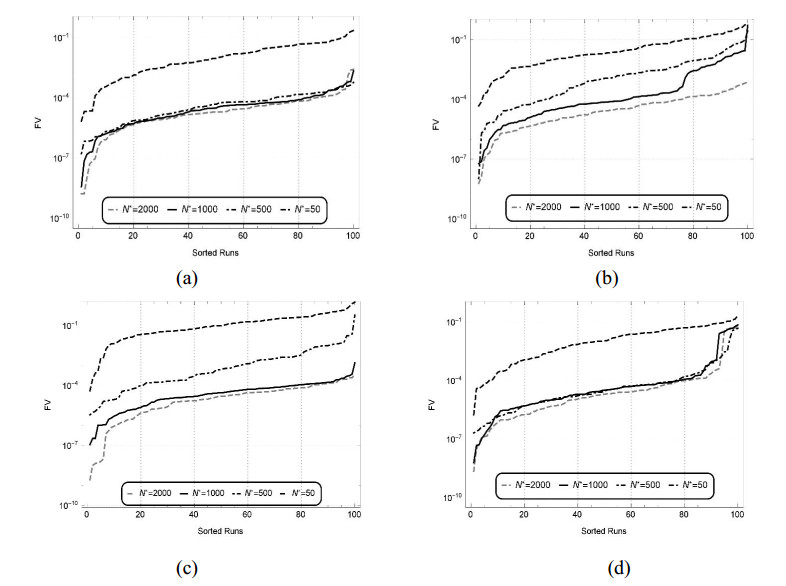In this work, a novel bio-inspired meta-heuristic framework is presented for the assessment of linear and non-linear multi-term fractional differential equations (MFDEs) based on the idea of residual power series method (RPSM) in amalgamation with the bat algorithm (BATA) which, mimics the echolocation behavior of the foraging bats. The bat-inspired based methodology has been implemented to solve MFDEs with different possible variants of two point boundary conditions. The BATA is utilized in the recommended new residual optimization technique (NROT) for the minimization of the energy function attained by the spirit of RPSM. Moreover, to ratify the correctness and accuracy of the deliberated technique the results are evaluated by using two other meta-heuristic optimization techniques i.e., differential evolution algorithm (DEA) and the accelerated particle swarm optimization algorithm (APSOA) for the learning of unknown weights in the derived fitness function. The accuracy and competency of the NROT is validated by comparing the BATA computed results with the exact solution and the corresponding data acquired by the DEA and APSOA. Furthermore, detailed performance analysis is performed through statistical inference based on the large number of independent runs.
1.
Introduction
Nonlinear evolution equations (NLEEs) play an important part in the study of nonlinear science, particular in plasma physics, quantum field theory, nonlinear wave propagation and nonlinear optical fibers so that it attracted the attention of a large number of scholars. The extended auxiliary equation technique [1], the Bernoulli's equation approach [2], the Exp-function technique [3], the homotopy analysis technique [4], the homotopy perturbation technique [5], the improved tan(ϕ/2)-expansion technique ([6,7]), the Hirota's bilinear technique [8,9,10,11,12,13,14,15], the He's variational principle [16,17], the binary Darboux transformation [18], the Lie group analysis [19,20], the Bäcklund transformation method [21], optimal galerkin-homotopy asymptotic method applied [22], and the multiple rogue waves method ([23,24]) have been proposed to solve NLEEs. By using these approaches, various exact solutions including soliton solution, lump solution, rogue wave solution, periodic solution, interaction solution, rational solution and high-order rational solution were obtained ([25,26]).
In this paper, we mainly consider the following dynamical model, which can be used to describe some interesting (3+1)-dimensional waves of physics, namely, the generalized Kadomtsev-Petviashvili (gKP) equation [27]. That is
and also above equation is integrable. Author of [28] introduced the modification of KP (mKP) equation [29] given
The generalized KP (gKP) equation has been researched by some scholars [30,31,32] in which is given as
The another type of gKP equation is given in [33] as below
We first present the bilinear form for Eq (1.4), by taking the following first-order logarithmic transformation
then, Eq (1.4) is turned into the bilinear form
in which Dt,Dx,Dy and Dz are Hirota's bilinear frames. Cao [34] investigated the generalized B-type KP equation as follows
Guan et al. [35] derived a (3+1)-dimensional gKP equation in below form
and some lump soliton solutions have been constructed using the Hirota bilinear method in [36]. Via transformation Ψ=2(lnf)x, the bilinear form of equation (1.8) reads:
Most classical test functions for solving NLPDEs by using the several particular functions can be constructed via Hirota bilinear technique. In other words, Hirota operator covers most of the classical hypothesis function method. For example, the fractional generalized CBS-BK equation [37], the generalized Bogoyavlensky-Konopelchenko equation [38], the (2+1)-dimensional asymmetrical Nizhnik-Novikov-Veselov equation [39], and the (2+1)-dimensional generalized variable-coefficient KP-Burgers-type equation [40]. Diverse kinds of studies on solve NLPDEs were perused via mighty authors in which some of them can be stated, for instance, multivariate rogue wave to some PDEs [41], interaction lump solutions the gKP equation [42], the (1+1)-dimensional coupled integrable dispersionless equations [43]. Therefore, we embark on the new research topic of constructing the analytic solutions of nonlinear PDEs by exploring the bilinear method. According to recent studies, we can obtain some of the new exact analytic solutions of nonlinear PDEs by way of constructing their corresponding bilinear differential equations in [44,45,46,47]. Here, we will study the multiple Exp-function method (MEFM) for determining the multiple soliton solutions (MSSs). The MEFM employed by some of powerful authors for various nonlinear equations have been surveyed in more studies in [31,48,49,50]. Authors of [51] utilized the reduced differential transform method for solving partial differential equations. Also, Yu and Sun [52] studied the dimensionally reduced generalized KP equations by help of Hirita bilinear method and obtained of lump solutions.
The outline of our paper is as follows: the multiple Exp-function scheme has been summarized in section 2. In sections 3, the KP equation, will investigate to finding 1-wave, 2-wave, and three-wave solutions. The Sections 4-6 devote to determined the periodic, cross-kink, and solitary wave solutions. Moreover, in Section 7, the modulation instability analysis is investigated. Finally in Section 8, the SIVP technique is considered with four cases for finding the solitary, bright, dark and singular wave solutions. A few of conclusions and outlook will be given in the final section.
2.
Multiple Exp-function method
This method was summarized and improved for achieving the analytic solutions of NLPDEs:
Step 1. Assume a nonlinear PDE is given in general frame as follows
Take the novel variables ξi=ξi(x,y,z,t),1≤i≤n, by differentiable frames:
where αi,βi,γi,1≤i≤n, are unfound amounts. It noted that one can get as the following function
where ϖi,1≤i≤n, unspecified amounts.
Step 2. Assuming the solution of the Eq (2.1) is function of variables ξi,1≤i≤n:
in which Δrs,ij and Ωrs,ij are amounts to be remained. Replacing Eq (2.4) into Eq (2.1) can be achieved the below form as:
and also we have
3.
MSSs for the (3+1) gKP equation
3.1. Option I: 1-wave solution
The one-wave function of the solution will be reduced as below form
in which ρ1,ρ2,σ1 and σ2 are unspecified amounts. Substituting (3.1) into Eq (1.8), the below cases will be concluded as:
Case I:
Case II:
Case III:
Case IV:
in which ϑ, solves the equation λ1ϑ4+(γ1λ3−αγ1λ2)ϑ3+(γ1λ1ω2−γ1λ2ω1)ϑ−γ21ω3λ2+γ21λ3ω2=0.
For example, the 1-wave solution for Case III will be considered as
3.2. Option II: 2-wave solutions
The two-wave function of the solution will be reduced as below form
Substituting (3.7) in terms of (3.8) into Eq (1.8), the below cases will be resulted as:
Case I:
Case II:
Case III:
Case IV:
Case V:
Case VI:
Case VII:
Case VIII:
For instance, the 2-wave solution for Case I will be taken as
Also, the 2-wave solution for Case III will be considered as
And finally, the resulting two-wave solution for Case VIII will be read as
3.3. Option III: Triple-wave solutions
The triple-wave function of the solution will be reduced as below form
in which Λi=αix+βiy+γix−δit,i=1,2,3. Inserting (3.20) in terms of (3.21) into Eq (1.8), the below case will be reached:
Then, the solution is
in which Λi=αix−αγiy+γix−γi(αγiω 2−αiω1−ω3γi)αγiλ2−αiλ1−γiλ3 t,i=1,2,3 and Ψ=Ψ(x,y,z,t).
4.
Novel periodic wave solutions
The triangular periodic waves for Eq (1.8) can be assumed as below:
in which ai,i=1,...,17 are unfound values. Substituting (4.1) and (4.2) into Eq (1.8) the below consequences will be gained:
Case I:
Appending (4.3) into (4.1) and (4.2), the soliton-periodic wave solution of Eq (1.8) as below will be achieved:
By selecting the suitable values of parameters including
the graphical display of soliton-periodic wave solution is offered in Figure 1 such as 3D plot and density plot.
Case II:
Plugging (4.5) into (4.1) and (4.2), obtain a soliton-periodic wave solution of Eq (1.8) as below case:
Case III:
Incorporating (4.7) into (4.1) and (4.2), the soliton-periodic wave solution of Eq (1.8) will be gained as below:
Case IV:
Plugging (4.9) into (4.1) and (4.2), the soliton-periodic wave solution of Eq (1.8) will be achieved as below:
Case V:
Incorporating (4.11) into (4.1) and (4.2), we capture a soliton-periodic wave solution of Eq (1.8) as below:
Case VI:
Appending (4.13) into (4.1) and (4.2), the soliton-periodic wave solution of Eq (1.8) will be obtained as below:
By selecting suitable values of parameters including
the graphical display of soliton-periodic wave solution is offered in Figure 2 such as 3D chart and density chart.
Case VII:
Incorporating (4.15) into (4.1) and (4.2), the soliton-periodic wave solution of Eq (1.8) will be received as below:
By selecting the specific amounts of parameters including
the graphical display of soliton-periodic wave solution is offered in Figure 3 such as 3D chart, density chart, and 2D chart and below cases:
5.
Novel cross-kink wave solutions
Three function containing exponential, hyperbolic, and triangular periodic waves for Eq (1.8) can be assumed as the following:
in which ai,i=1,...,17 are unfound values. Substituting (5.2) into Eq (1.8) the below consequences will be gained:
Case I:
Substituting (5.3) into (5.1) and (5.2), the cross-kink solution of Eq (1.8) will be gained as the following:
By selecting the suitable values of parameters including
the graphical representation of cross-kink wave solution is offered in Figure 4 such 3D plot and density plot.
Case II:
Putting (5.5) into (5.1) and (5.2), the cross-kink solution of Eq (1.8) will be received as the following:
By selecting the suitable values of parameters including
the graphical exhibition of cross-kink solution is offered in Figure 5 such as 3D chart and density chart.
Case III:
Plugging (5.7) into (5.1) and (5.2), the cross-kink solution of Eq (1.8) will be obtained as the following:
Case IV:
Inserting (5.9) into (5.1) and (5.2), the cross-kink solution of Eq (1.8) will be gained as the following:
Case V:
Substituting (5.11) into (5.1) and (5.2), the cross-kink solution of Eq (1.8) will be received as the following:
By selecting the suitable values of parameters including
the graphical exhibition of cross-kink solution is offered in Figure 6 such as 3D chart and density chart.
Case VI:
Putting (5.13) into (5.1) and (5.2), the cross-kink solution of Eq (1.8) will be concluded as the following:
By selecting suitable values of parameters including
the graphical representation of cross-kink solution is offered in Figure 7 such as 3D chart and density chart.
Case VII:
Inserting (5.15) into (5.1) and (5.2), the cross-kink solution of Eq (1.8) will be gained as the following:
By selecting suitable values of parameters including
the graphical representation of cross-kink solution is offered in Figure 8 such as 3D chart and density chart.
6.
Novel solitary wave solutions
Three function containing exponential, hyperbolic, and triangular periodic waves for Eq (1.8) can be assumed as the following:
in which ai,i=1,...,17 are unfound values. Substituting (6.2) into Eq (1.8) the below consequences will be gained:
Case I:
Substituting (6.3) into (6.1) and (6.2), we can capture a solitary wave solution of Eq (1.8) as the following:
Case II:
Inserting (6.5) into (6.1) and (6.2), we can capture a solitary wave solution of Eq (1.8) as below:
Case III:
Putting (6.7) into (6.1) and (6.2), the solitary wave solution of Eq (1.8) can be indicated as below:
Case IV:
Putting (6.9) into (6.1) and (6.2), the solitary wave of Eq (1.8) can be stated as the following:
By selecting the suitable values of parameters including
with the following components
the graphical representation of rational solitary solution is offered in Figure 9 such as 3D chart and density chart.
Case V:
Incorporating (6.11) into (6.1) and (6.2), the solitary solution of Eq (1.8) will be gained as below:
Case VI:
Appending (6.13) into (6.1) and (6.2), the solitary solution of Eq (1.8) can be written as the following:
Case VII:
Appending (6.15) into (6.1) and (6.2), the solitary solution of Eq (1.8) will be obtained as below:
By choosing the specific amounts of parameters including
the graphical representation of rational solitary solution is offered in Figure 10 such as 3D chart and density chart.
Case VIII:
Incorporating (6.17) into (6.1) and (6.2), the solitary solution of Eq (1.8) will be received as below:
Case IX:
Appending (6.21) into (6.1) and (6.2), the solitary solution of Eq (1.8) can be reached as below:
Case X:
Inserting (6.21) into (6.1) and (6.2), the solitary solution of Eq (1.8) will be gained as below form:
By choosing the specific amounts of parameters including
the graphical representation of rational solitary solution is offered in Figure 11 such as 3D chart and density chart.
Case XI:
Inserting (6.25) into (6.1) and (6.2), the solitary solution of Eq (1.8) can be stated as below case:
Case XII:
Inserting (6.27) into (6.1) and (6.2), the solitary solution of Eq (1.8) will be gained as below form:
7.
Stability analysis of Eq (1.8)
In the current section, we will analyze the continuous modulational instability of the nonlinear generalized KP equation. In addition, the feasibility of the localized waves in the present system is certified by linear stability analysis. First, we search the perturbed solution for the giving Eq (1.8) of the form
where Θ=Θ(x,y,z,t) and ζ is a steady state solution. Inserting (7.1) into Eq (1.8), become
by linerization Eq (7.2), one gets
Theorem 7.1. Assume that the solution of Eq (7.3) has the following case as
in which M,N,P are the normalized wave numbers, by plugging (7.4) into Eq (7.3), separation the coefficients of ei(Mx+Ny+Pz+Wt) one gets
Proof. By putting (7.4) into (7.3), becomes
in which ¯Θ=Θ(x,y,z,t). By solving and simplifying we can determine the function of B(M,N,P) as the following
Accordingly, the considered solution was obtained. Thereupon the proof is perfect.
It is easy to notice that modulation stability occurs when Mλ1+Nλ2+Pλ3≠0. So, the modulation stability achieve spectrum Υ(B) will be as below form:
In Figures 12-14 can be discovered that while the sign of B(M,N,P) is positive for all quantity of M. Furthermore, in Figure 12 can be observed if the B(M,N,P) is positive or negative for some quantities of M. Finally, in Figure 13 and 14 can be perceived that while the sign of B(M,N,P) is positive for all quantity of M.
8.
Usage of SIVP for Eq (1.8)
Via employing the wave alteration ξ=k(x+ay+bz−ct) in Eq (1.8) once can gain to the below ODE as
in which Ψ=Ψ(ξ) and Ψ′=dΨdξ. According to the SIVP [16,17] and by multiplying Eq (8.1) with Ψ′ and integrating once respect to ξ, the following stationary integral will be arises
in which
8.1. Case I
We utilize the solitary wave function as the following
Hence, the stationary integral transforms to
Based on the SIVP and using derivative J respect to A and B, one get
and
Solve the Eqs (8.5) and (8.6), become
The condition can be obtained as below
Finally, the solitary solution received by utilizing of SIVP can be reached as
8.2. Case II
We utilize the bright wave function as the following
Hence, the stationary integral transforms to
Based on the SIVP and using derivative J respect to A and B, one get
and
Solve the Eqs (8.12) and (8.13), become
The condition of definition of the above relations can be expressed as
Finally, the solitary solution gained by utilizing of SIVP will be as
8.3. Case III
Assume the dark soliton wave solution be as the below case as
Hence, the stationary integral transforms to
Based on the SIVP and using derivative J respect to A and B, one get
and
Solve the Eqs (8.19) and (8.20), one get
The condition of definition of the above relations can be presented the following form
Finally, the dark solution acquired by utilizing of SIVP will be as
8.4. Case IV
Let the singular soliton wave solution be as the below case as
Then, the stationary integral transforms to
Based on the SIVP and using derivative J respect to A and B, become
and
Solve the Eqs (8.26) and (8.27), one get
The condition of definition of the above relations can be presented as the below form as
Finally, the singular solution acquired by utilizing of SIVP will be as
9.
Conclusion
In this article, the MEFM employed for searching the MSSs for the gKP equation, which contains 1-wave, 2-wave, and 3-wave solutions. The periodic wave, cross-kink, and solitary wave solutions have been obtained. In continuing, the modulation instability applied to discuss the stability of earned solutions. It is quite visible that these novel schemes have plenty of family solutions containing rational exponential, hyperbolic, and periodic functions with selecting particular parameters. Also, the semi-inverse variational principle will be used for the gKP equation. Four major cases containing the solitary, bright, dark and singular wave solutions were studied from four different ansatzes.
By means of symbolic computation, these analytical solutions and corresponding rogue waves are obtained. Via various curve plots, density plot and three-dimensional plots, dynamical characteristics of these rouge waves are exhibited. Because of the strong nonlinear characteristic of Hirota bilinear method, the test function constructed by the Hirota operator, which can be regarded as the test function constructed by considered model. The results are beneficial to the study of the plasma, optics, acoustics, fluid dynamics and fluid mechanics. All computations in this paper have been employed quickly with the help of the Maple 18. Moreover, the method applied in this paper provides an effective tool to obtain exact solutions of nonlinear system and can in common use for other NLEEs.
Acknowledgments
This work is supported by the Education and scientific research project for young and middle-aged teachers of Fujian Province (No. JAT.190666-No.JAT200469)
Conflict of interest
The authors declare that there is no conflict of interests regarding the publication of this paper.
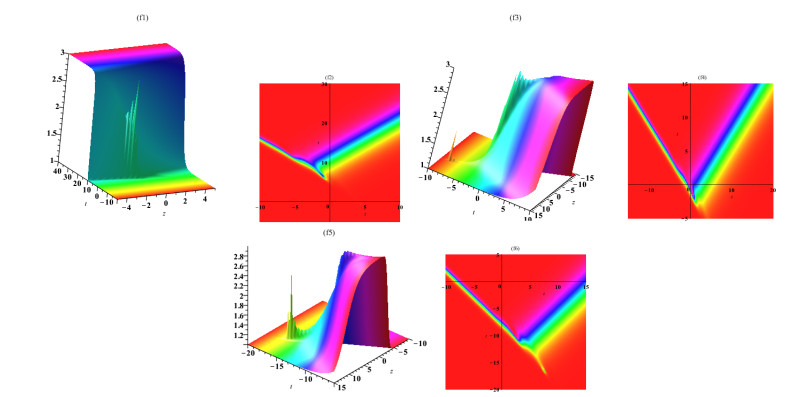









 DownLoad:
DownLoad:















